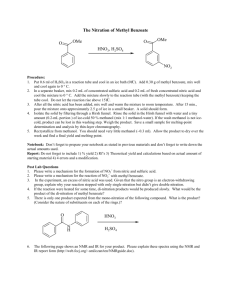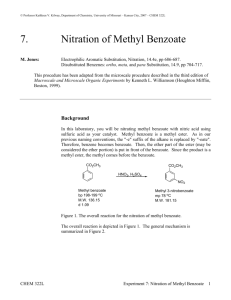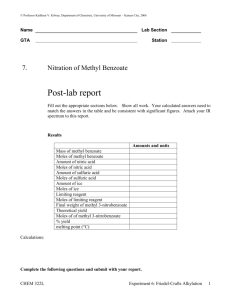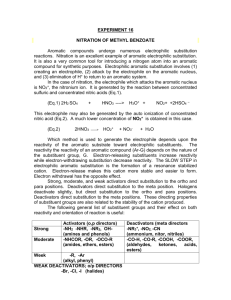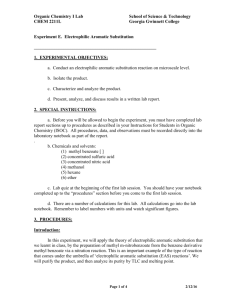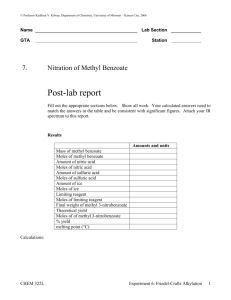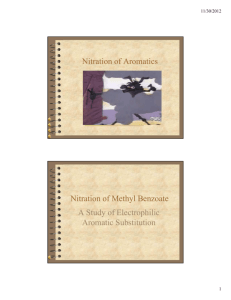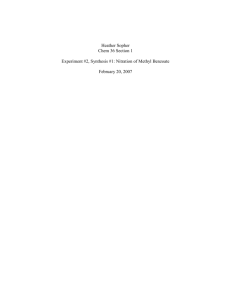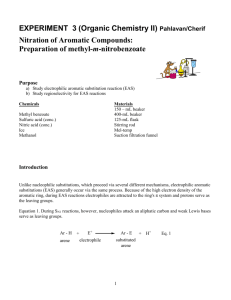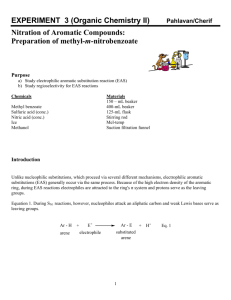Nitration of Methyl Benzoate Lab Report
advertisement
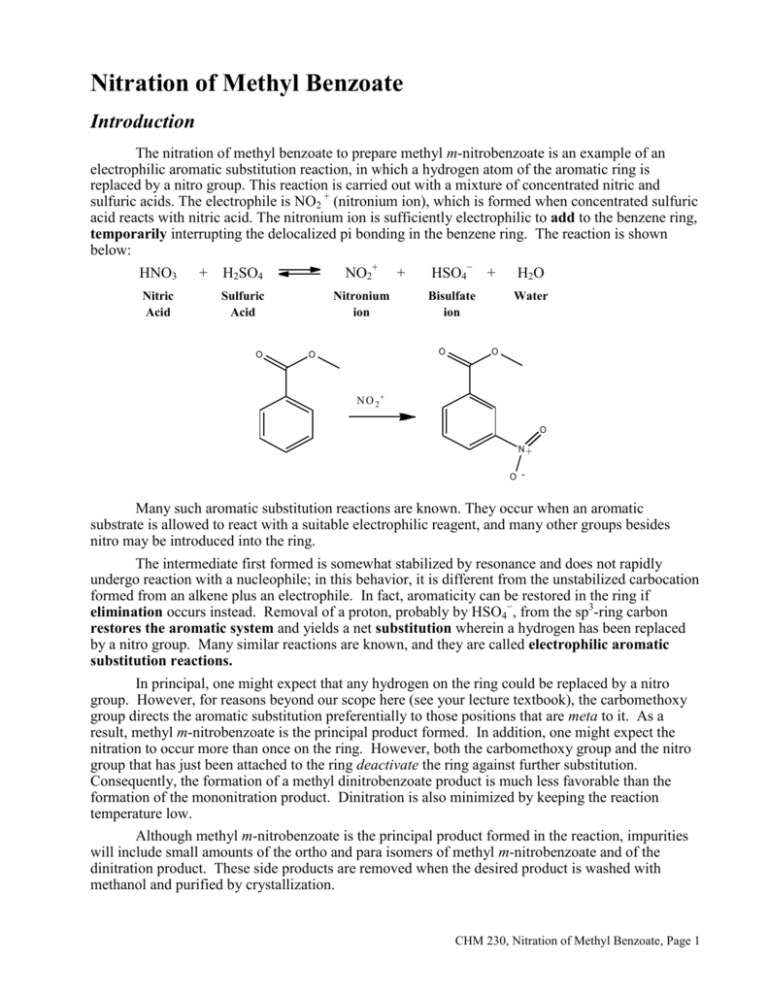
Nitration of Methyl Benzoate Introduction The nitration of methyl benzoate to prepare methyl m-nitrobenzoate is an example of an electrophilic aromatic substitution reaction, in which a hydrogen atom of the aromatic ring is replaced by a nitro group. This reaction is carried out with a mixture of concentrated nitric and sulfuric acids. The electrophile is NO2 + (nitronium ion), which is formed when concentrated sulfuric acid reacts with nitric acid. The nitronium ion is sufficiently electrophilic to add to the benzene ring, temporarily interrupting the delocalized pi bonding in the benzene ring. The reaction is shown below: HNO3 + H2SO4 NO2+ + HSO4− + H2O Nitric Acid Sulfuric HN O 3 Acid O + H 2 SONitronium 4 ion Bisulfate ion O O Water N O 2 + + H SO 4 - + H 2 O O N O 2+ O N+ O - Many such aromatic substitution reactions are known. They occur when an aromatic substrate is allowed to react with a suitable electrophilic reagent, and many other groups besides nitro may be introduced into the ring. The intermediate first formed is somewhat stabilized by resonance and does not rapidly undergo reaction with a nucleophile; in this behavior, it is different from the unstabilized carbocation formed from an alkene plus an electrophile. In fact, aromaticity can be restored in the ring if elimination occurs instead. Removal of a proton, probably by HSO4−, from the sp3-ring carbon restores the aromatic system and yields a net substitution wherein a hydrogen has been replaced by a nitro group. Many similar reactions are known, and they are called electrophilic aromatic substitution reactions. In principal, one might expect that any hydrogen on the ring could be replaced by a nitro group. However, for reasons beyond our scope here (see your lecture textbook), the carbomethoxy group directs the aromatic substitution preferentially to those positions that are meta to it. As a result, methyl m-nitrobenzoate is the principal product formed. In addition, one might expect the nitration to occur more than once on the ring. However, both the carbomethoxy group and the nitro group that has just been attached to the ring deactivate the ring against further substitution. Consequently, the formation of a methyl dinitrobenzoate product is much less favorable than the formation of the mononitration product. Dinitration is also minimized by keeping the reaction temperature low. Although methyl m-nitrobenzoate is the principal product formed in the reaction, impurities will include small amounts of the ortho and para isomers of methyl m-nitrobenzoate and of the dinitration product. These side products are removed when the desired product is washed with methanol and purified by crystallization. CHM 230, Nitration of Methyl Benzoate, Page 1 CAUTION: It is important that the temperature of the reaction mixture be maintained below 15°C. Nitric acid and sulfuric acids, especially when mixed, are very corrosive substances. Be careful not to get these acids on your skin. If you do get some of these acids on your skin, flush the affected area liberally with water. Procedure: Add 0.21 mL of methyl benzoate to a tared 3-mL conical vial, and determine the actual weight of methyl benzoate. Add 0.45 mL of concentrated sulfuric acid to the methyl benzoate along with a magnetic spin vane. Attach an air condenser to the conical vial. The purpose of the air condenser is to make it easier to hold the conical vial in place. Prepare an ice bath in a 250-mL beaker using both ice and water. Clamp the air condenser so that the conical vial is immersed in the ice bath. Cool 0.30 mL of nitrating mixture (1:1 conc. Sulfuric acid: conc. Nitric acid) in an ice bath. While stirring, very slowly add the cold nitrating mixture to the methyl benzoate, sulfuric acid mixture in the conical vial. The addition should take about 15 minutes. The acid mixture should be added with a 9-inch Pasteur pipet through the top of the air condenser. If the addition is too fast, the formation of by-product increases rapidly, reducing the yield of the desired product. After you have added all the acid, warm the mixture to room temperature by replacing the ice water in the 250-mL beaker with water at room temperature. Let the reaction mixture stand for 15 more minutes without stirring. Then, using a Pasteur pipet, transfer the reaction mixture to a 20-mL beaker containing 2.0 g of crushed ice. After the ice has melted, isolate the product by vacuum filtration using a Hirsch funnel, and wash it with two 1.0-mL portions of cold water and then with two 0.3-mL portions of ice-cold methanol. Weigh the crude, dry product. Determine the melting point and obtain the infrared spectrum of the product. Waste disposal The filtrate from the Hirsch funnel filtration should be placed in the waste container. CHM 230, Nitration of Methyl Benzoate, Page 2 Name ____________________________________ Nitration of Methyl Benzoate Report Mass of vial and methyl benzoate: Mass of vial: Mass of methyl benzoate: Mass of methyl m-nitrobenzoate Write the balanced equation for the reaction. Show your calculation for the percent yield of methyl m-nitrobenzoate. CHM 230, Nitration of Methyl Benzoate, Page 3 Questions 1. Attach your IR spectrum to your report with major peaks above 1600 cm−1 labeled and interpreted. 2. Write equations, using structural formulas, for the major product(s) that results from the mononitration of: A, benzene; B, toluene; C, chlorobenzene; D, benzoic acid; E, nitrobenzene. a. b. c. d. e. CHM 230, Nitration of Methyl Benzoate, Page 4 3. Using your textbook or other reference, show the mechanism of the nitration of methyl benzoate. Show all relevant resonance structures for intermediates and show how the carbomethoxy group participates in directing the nitro group to the meta position. CHM 230, Nitration of Methyl Benzoate, Page 5
